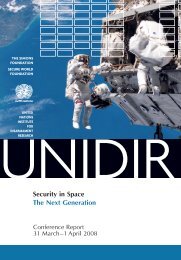Missile Defence, Deterrence and Arms Control - UNIDIR
Missile Defence, Deterrence and Arms Control - UNIDIR
Missile Defence, Deterrence and Arms Control - UNIDIR
Create successful ePaper yourself
Turn your PDF publications into a flip-book with our unique Google optimized e-Paper software.
THREAT ASSESSMENT<br />
While the 1991 Gulf War demonstrated the capacity of small States<br />
such as Iraq to acquire short-range ballistic missile capabilities for use in<br />
tactical settings, it is the growing propensity of such nations to acquire<br />
longer-range capabilities to be used in non-theatre scenarios that the<br />
United States of America cites as one of its most pressing international<br />
security threats. Currently, 38 States possess some functional form of<br />
ballistic missile capability. Of these, however, only 11 have medium<br />
range (>1,000 km range) capacity, <strong>and</strong> only the five permanent<br />
members of the Security Council have intercontinental ballistic missile<br />
(ICBM) capability. 1 The 1998 Commission to Assess the Ballistic <strong>Missile</strong><br />
Threat to the United States, chaired by current Secretary of Defense<br />
Donald Rumsfeld, was charged with examining the likelihood of hostile<br />
States to progress from short-range or intermediate-range capabilities to<br />
long-range technology. Specifically, the Rumsfeld Commission<br />
highlighted the growing ballistic missile capabilities of so-called “rogue<br />
States” such as the Democratic People’s Republic of Korea (DPRK), Iran<br />
<strong>and</strong> Iraq. The timeline for such nations to acquire ICBM capabilities was<br />
posited as early as five years for some States, <strong>and</strong> in the order of a<br />
decade for others. Iran, for example, has successfully tested the 1,500<br />
km range Shahab-3 missile 2 of which it is now developing longer-range<br />
versions.<br />
Of greatest concern to Washington, however, is the DPRK’s<br />
acquisition of indigenous ICBM <strong>and</strong> nuclear capabilities. Pyongyang has<br />
already successfully flight-tested its 1,500 km range No-Dong missile <strong>and</strong><br />
proceeded to transfer that technology to Iran <strong>and</strong> Pakistan. Six weeks<br />
after the Rumsfeld Commission report was released, the DPRK flighttested<br />
a Taepo-Dong 1 missile over the Sea of Japan which, contrary to<br />
1<br />
2<br />
A short-range ballistic missile (SRBM) has a range of less than 1,000 km. A<br />
medium-range ballistic missile (MRBM) has a range of between 1,000 km<br />
<strong>and</strong> 3,000 km. An intermediate-range ballistic missile (IRBM) has a range<br />
of between 3,000 km <strong>and</strong> 5,500 km. An ICBM has a range of more than<br />
5,500 km.<br />
A derivative of the DPRK’s No-Dong missile.<br />
1








